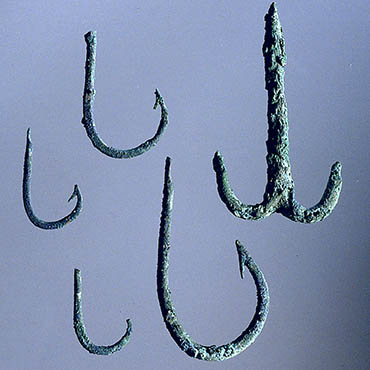6. Hunting and fishing

The Vesuvian region, spreading from the seashore to the foothills and then to the mountain forests, provided ideal large game habitats far from inhabited areas. The territory was along the route of the great seasonal bird migrations, offering excellent fowl-hunting conditions. Hunting tools included bows and arrows, as well as snares and nets in suitable sizes. Prey were lured using calls, or caught by means of traps. Once the meat had been eaten, the largest bones were worked to make everyday or ornamental items while fangs and horns were kept as trophies.
Fishing techniques were highly developed and differed little from those still practiced today. A large number of bronze fish-hooks and various types of nets have been found. These, together with the descriptions passed down by classical writers and in artistic portrayals, offer us a complete overview of how the Romans gathered food resources from the sea. They even practiced undersea fishing by diving with special harpoons.
In the classical world, hunting was widely practised. Among the most sought-after prey were varieties of deer, including roe-deer, that populated the hills and woods of the Vesuvian region. The hunter engaged the prey in a chase that ended by running down the animal with the help of dogs.
Most risky was the hunt of the wild boar: the animal was endowed with terrible tusks and if wounded, attacked humans. The most courageous hunters waited for an approaching boar, standing still and holding out a short stake so that the beast would impale itself while attacking.
The uplands at the north and east of the Vesuvian plain were also inhabited by bears, which were hunted. For hunting hare a special club was used, as well as nets, snares and swift greyhound-like dogs. Similar techniques were used for hunting birds.
Fish were caught either with baited hook and line, or with nets. The nets were made of vegetable fibres, often linen, and were repaired when necessary with specially made net-hooks. The Pompeians used two types of nets: those which are still in use today, and so-called casting nets. Mollusks and bivalves were also gathered.

